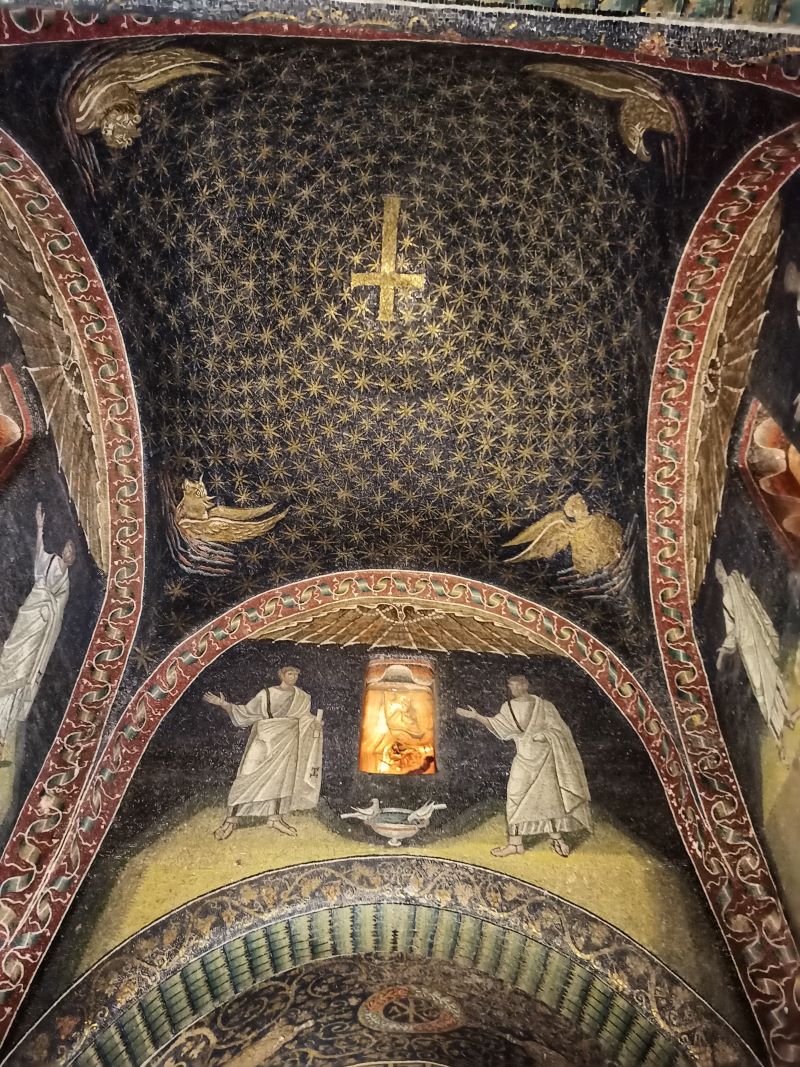It’s March in Italy and the weather can get a bit iffy. When you are a Later gap Traveler, this is the time you should probably wait until Wednesday to plan and base your itinerary on which side of the country looks drier. Taking our own advice, we checked our weather apps (we have a couple as we figure it’s always good to get a second opinion) – and decided that east was better than west. With that big decision out of the way, we now had to settle exactly where in the east we wanted to go. My wife had heard about Ravenna, located a little south of Venice, and had wanted to check it out for a while. We had been to Riccione (a nearby town) when our daughters were swimming (many, many years ago, the first year living in England), but had spent pretty much the entire time at the pool (it’s nice (link here), but we knew there was more to the area). Coincidently, my sister-in-law just happened to send a link to an article on Ravenna that same week – we took that as a sign.
Touristic – Not Touristy
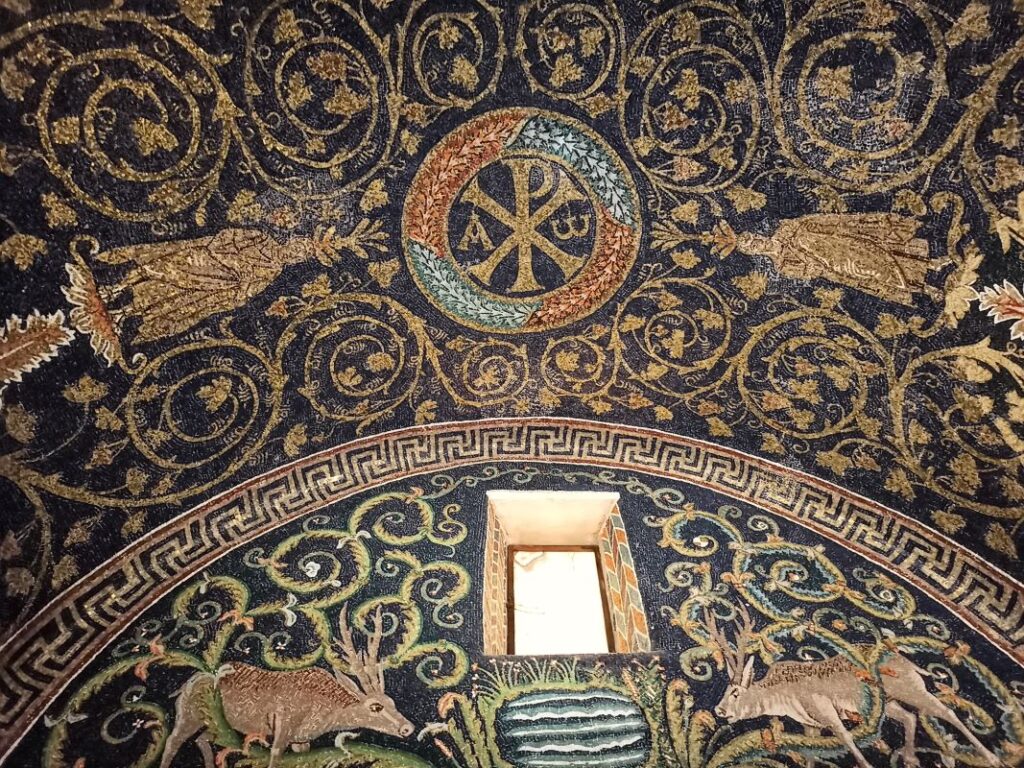
The first thing about Ravenna, it is described in a Travel + Leisure article, “This underrated Italian city has UNESCO-listed monuments and delicious food and wine”. What this means is that this less touristy spot is full of many of the great things that Italy has to offer. Just two hours from Florence or Venice, and one hour from Bologna, Ravenna sits on the coast of the Adriatic and is home to several UNESCO World Heritage sites. And we now only had two days to plan – good thing it was off-season (less touristy doesn’t mean non-touristy and it can get busy in the summer). We decided to stick to our usual sources of information – YouTube and bloggers (we are still recovering from our AI itinerary to Puglia). We decided we would leave right after work on Friday, and our first big decision was whether we should drive or relax on the train.
Looking at our trusty Trainline App, we discovered that the decision was kind of made for us – the drive would take around 3 hours, the train trip was over 4 with 2 changes; and the return was worse, with limited options in the afternoon. So much for relaxing. We booked a hotel near the Old Town. (We like to stay in hotels and near the old sections. We have had a couple of “interesting” experiences with apartments – nothing bad, just interesting, and we prefer to save interesting for walking around the alleyways and finding fun little restaurants. And typically, the prices are better if you stay near rather than in, plus you get to enjoy the stroll.)
But Still Need Dinner Reservations
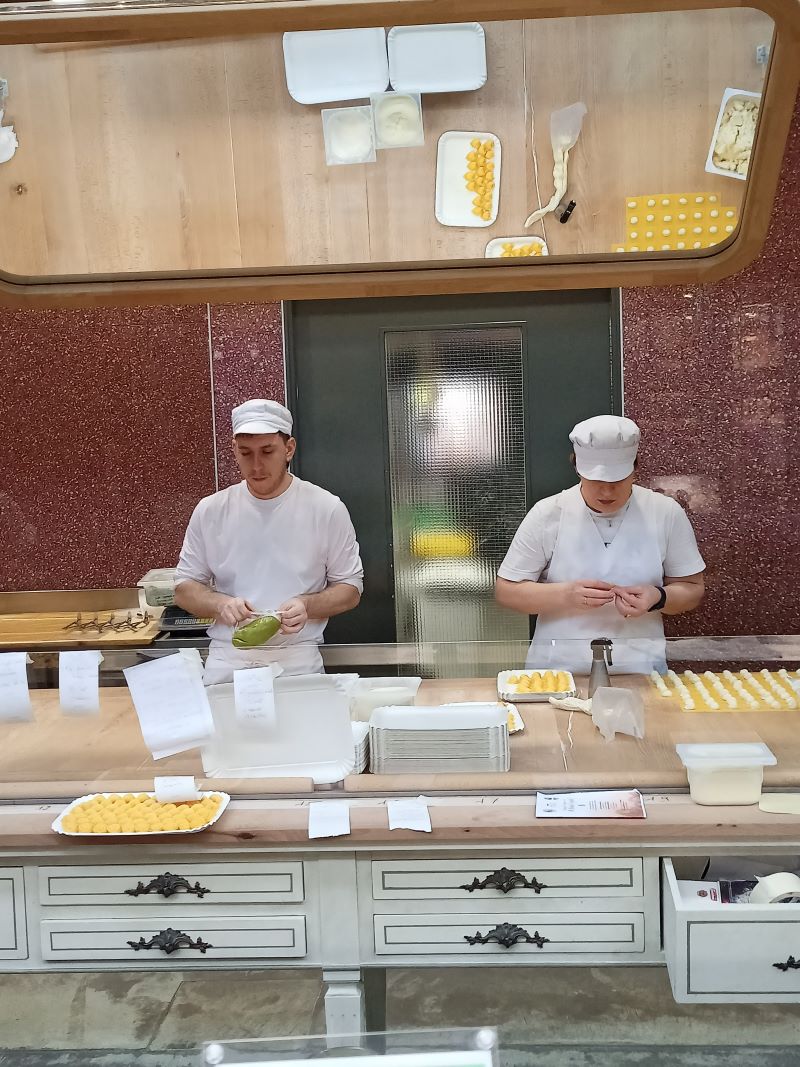
Next was a restaurant for Friday night. There looked to be one right near the hotel, and we were getting in a bit late, so it was nearly perfect – until I called and found out they were full. Being able to wait until the last minute to plan is great – but it can have its drawbacks. Friday midday I started the scramble, looking through the Travel & Leisure article for something in our area (not my usual modus operandi – those places can sometimes be overhyped – kind of like Blogger & Vlogger echo chambers occasionally seem.) One of the places mentioned was nearby (Antica Trattoria Al Gallo 1909). I called and they had a table available – not at the time I asked for but close enough. I took it, beggars can’t be choosers.
The drive turned out to be reasonably pleasant. It took about three hours, mostly on the autostrada, through the mountains between Florence and Bologna (replete with tunnels that were 3 – 5 kilometers long – pretty cool), not too much traffic and no traffic jams, and just a little bit of rain (east was less rainy than west, not necessarily non-rainy – kind of like less touristy, this time of year less rainy is the preferred option.) We arrived at the hotel, dropped off our bags, and hustled to the restaurant (the reservations were a bit earlier than I had asked and hoped for.) The interior was neat, we were one of the first tables seated – we looked around and thought the usual, “Why couldn’t we get a later reservation, the place is almost empty.” Service was great, we ordered our meal and wine, and (as usual) soon the place was full. The dinner was excellent, and the price was good – it is always refreshing to find places that are touted in magazines that live up to the promotion and manage to maintain reasonable prices.
Meeting Dante
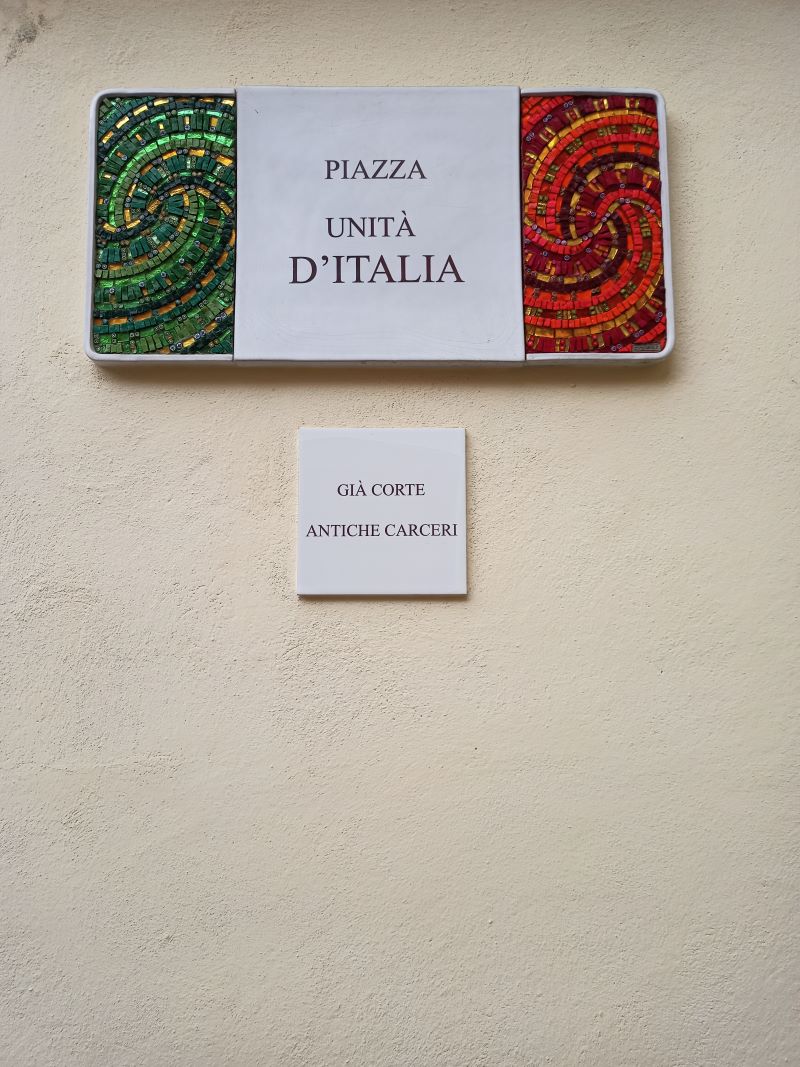
Saturday, we had booked a walking tour of the city, through our usual app, Get Your Guide. We wanted to see and hear about what made the city unique – from a local, not a blogging tourist. All these towns have special places, and these tours are great ways to see the “must-see” locales while finding out about the hidden gems. We got out early (9 AM, our tour wasn’t until 10) and stopped by a small pasticceria (coffee shop and bakery). They had cream-filled croissants that weighed about a pound and were to die for. After a cappuccino and a croissant, we wandered through the streets to our meeting point – near the Tourist Information office and Dante’s Tomb.
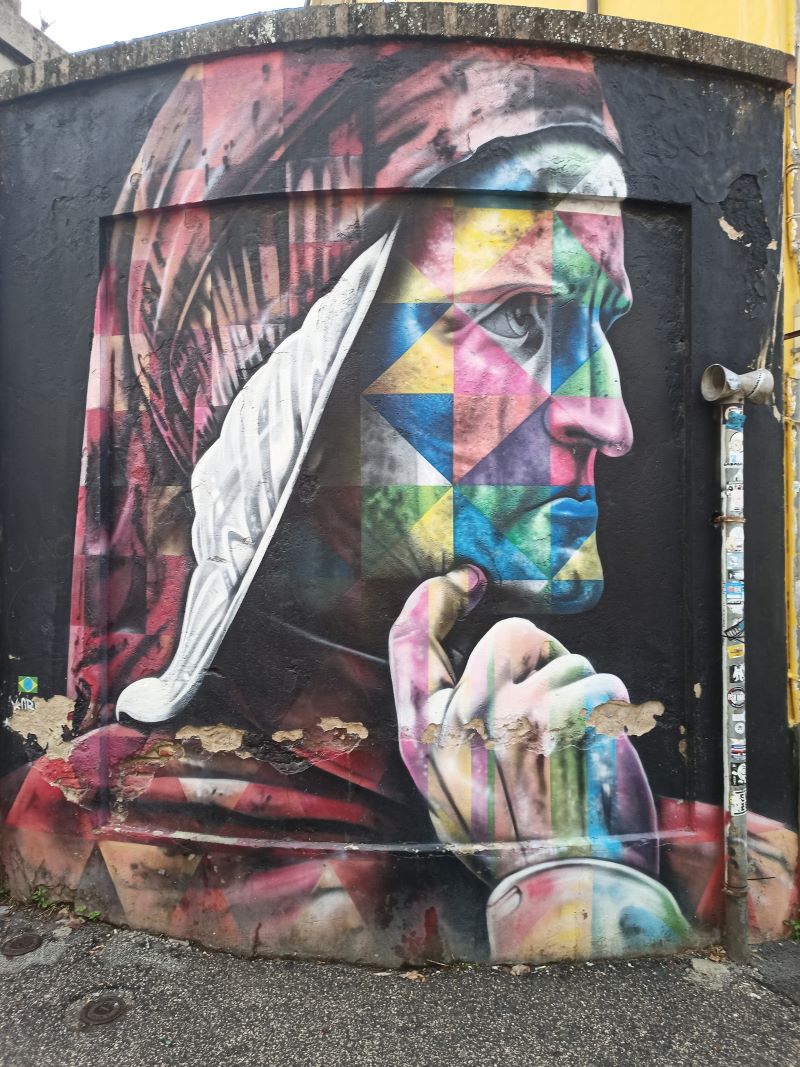
Dante Alighieri, the author of The Divine Comedy with seven levels of hell, is buried in Ravenna. (Side note: Firenza (Florence) also claims his remains. He is originally from there but was kicked out due to his political activities – Ravenna’s leadership welcomed him in and that was where he wrote his best-known work and ultimately died. The Divine Comedy contains references to many of Ravenna’s mosaics. I think most folks agree he is likely interred in Dante’s Tomb.) He is also quite prominent around the city. There is a museum dedicated to him (we didn’t go), as well as a theater named after him, and the people talk about him as the adopted son. In 2016, for the anniversary of his death, Ravenna’s mayor hired Korba, a tagger (street artist/graffiti painter) from Brazil (well known for his style and the social commentary of his work), to “tag” a wall with Dante’s image – I think it looks cool.
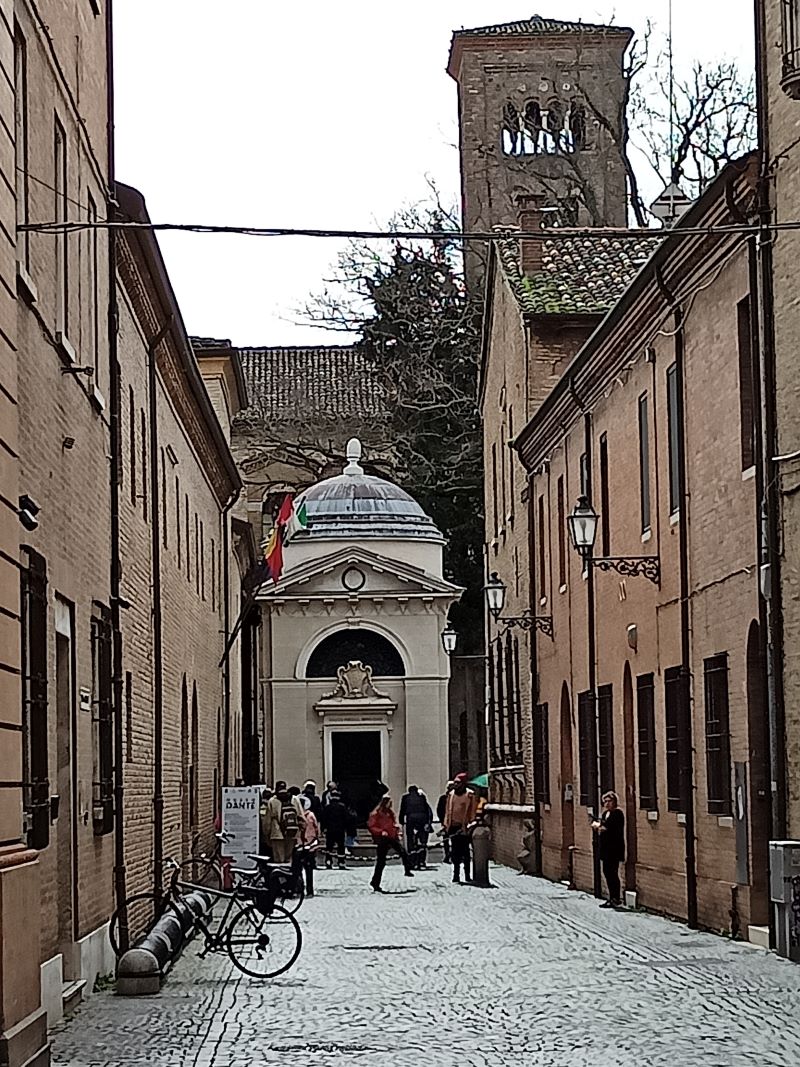
The tour focused on the main attractions of Ravenna – the UNESCO World Heritage mosaics adorning the interiors of several of the old churches. As well as seeing the beautiful artwork, we learned Ravenna was the original Venice, and was also the capital of both the Roman and Byzantine Empires. Two thousand years ago, the city was adjacent to the sea and acted as an important military and trading post. Years of buildup have now made the original port and lagoon inaccessible, and the city and surrounding area are several feet higher than they used to be (although it is still pretty much at sea level.) The city is also still connected to the sea via a large canal. As the capital of both the Romans and Byzantines, various ruling factions built, then left, some incredible monuments.
People’s (Submerged) Church & Rewriting Mosaics
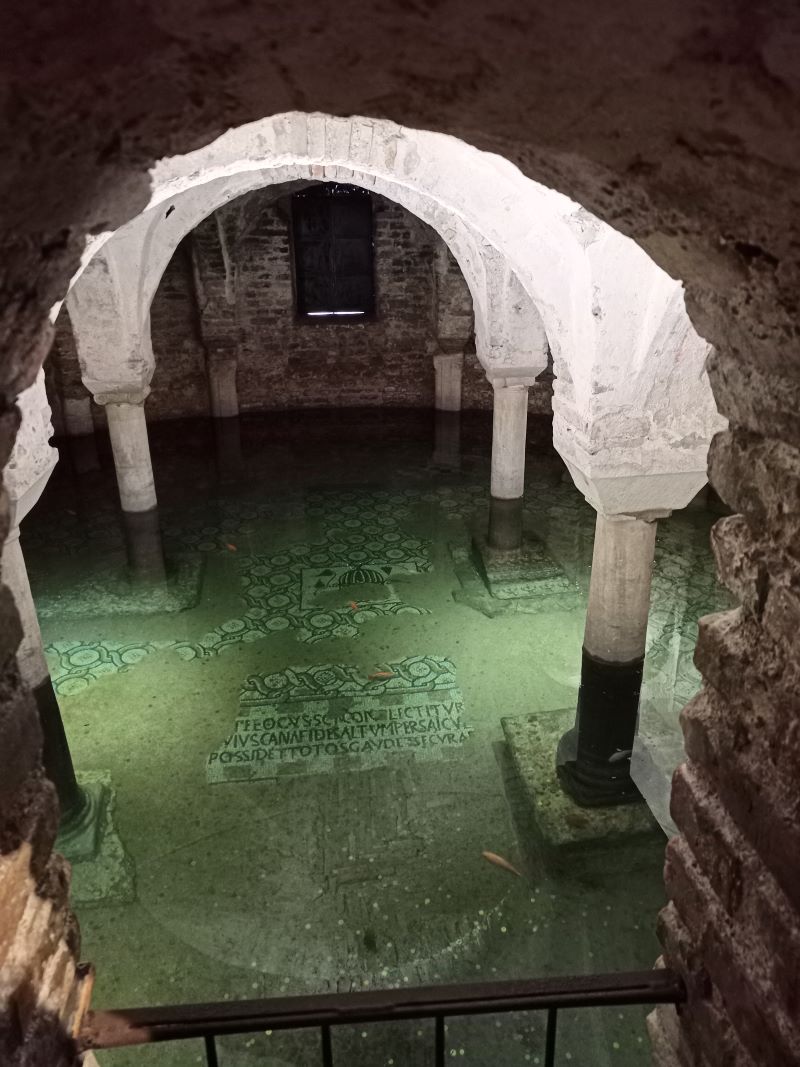
The first place we saw on our tour was the Basilica di San Francesco, what our guide called “the People’s Church.” The church was plain, as far as most Italian churches go, especially compared to some of the mosaic-adorned churches we would see later. We spent a few minutes looking around then the guide led us down some steps to peer into the apse under the altar. It was dark, but if you deposited one euro into the slot by the door lights would come on and you could see the entire area was flooded, with pillars rising from the pool and fish swimming peacefully through the clear water. Very interesting, and a catchy way to make a little money to help defray the costs of upkeep. The church wasn’t initially built underwater – this was the result of the building slowly sinking below the water table. The fish were brought in to eat mosquito eggs and help with pest control.

The next church we went into was the Basilica di Sant’Apollinare Nuovo (Saint Apollinare’s New Basilica – it’s only been around since the early 6th century and was renamed the “New” church in the 9th century, there is a different idea of old versus new over here.) The place was originally built as the private chapel of Theodoric, king of the Goths, but when they were kicked out later in the 6th century, the new Catholic rulers embarked on a campaign of “cancel culture”. The church hired masons to remove images of influential members of Theodoric’s court and replaced them with mosaics of curtains (they wanted to get rid of any traces the Goths had been there) – but you can still see parts of original hands or arms on the some of the columns in the Palatium mosaic.
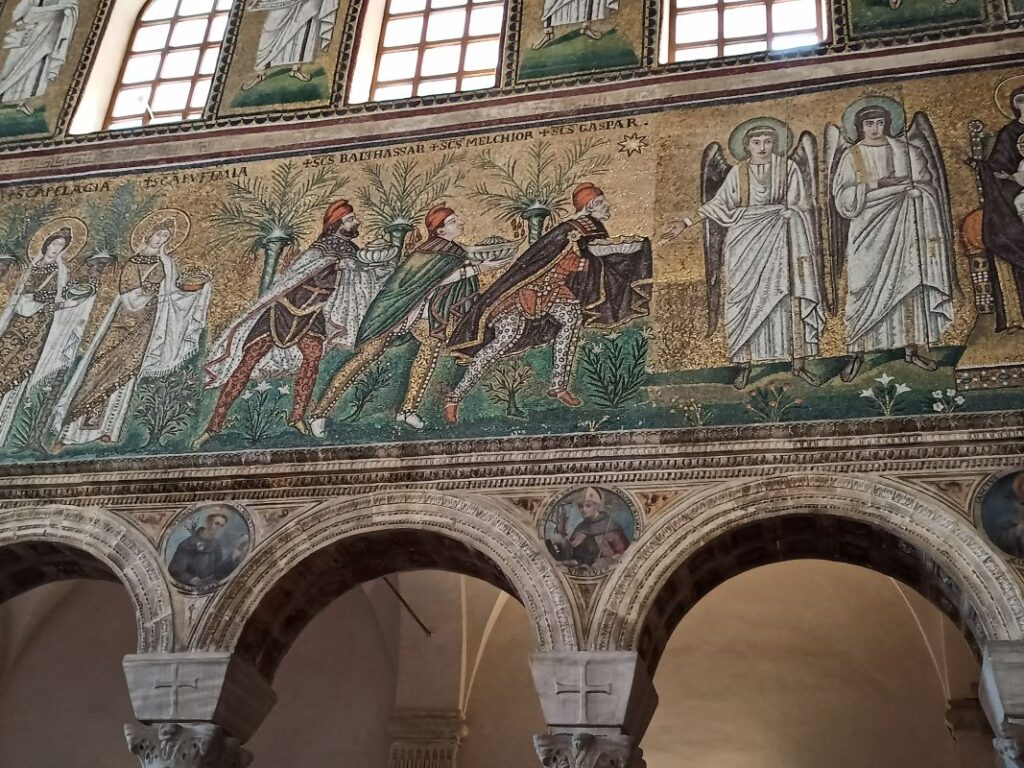
On one side of the main chapel, proceeding from the Palatium, is a mosaic of a line of martyrs (all male) with the depiction of a bearded, older image of Christ on the other end. The opposite side contains a line of virgins (all female) framed by a bird’s-eye view of civitas Classis (Ravenna’s Roman military harbor) and an image of a young, beardless Christ. Near the young image of Christ is a mosaic depicting the Magi, with their names inscribed above, supposedly the first “official naming” of the Three Wise Men. Above these mosaics are others depicting Christ’s life and various prophets.
Floor To Ceiling Mosaics – And Jewels
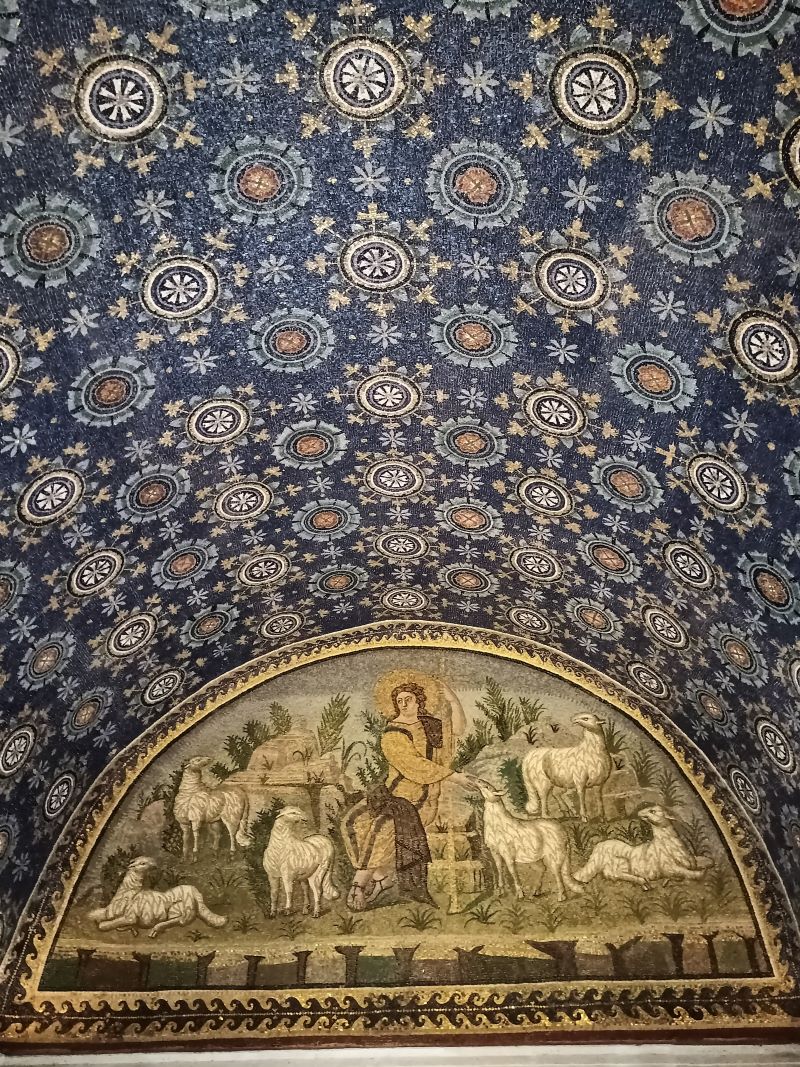
After the New Church, we went to the Mausoleo di Galla Placidia, a small mausoleum abutting the larger Basilica di San Vitale. Although small, the interior was incredible. We stood in line for about 10 minutes to get in. This was during March, during the low season. We stood in a long, straight line, but the ropes and stanchions, similar to the lines at TSA checkpoints in airports, were embedded in the concrete – I can only imagine what it must be like for the throngs of tourists during July and August (especially when the sun is beating down and the temperature is topping 100 degrees.) The mausoleum was built and decorated in the 5th century (which might be why the 6th-century basilica above was the “new” one.) The ceiling is a sea of stars and the four arms (it is built in the shape of a small cross) depict the four gospel writers – St Mark, St Luke, St Matthew, and St John. Above the door is an image of Christ in the wild, surrounded by, and feeding, his flock of sheep. We had read write-ups saying, “This is a must-see” – they were right. It is impossible not to appreciate the artistry and beauty of this small unimposing-looking building once you cross the threshold and experience what those artists, over 1500 years ago, were able to create.
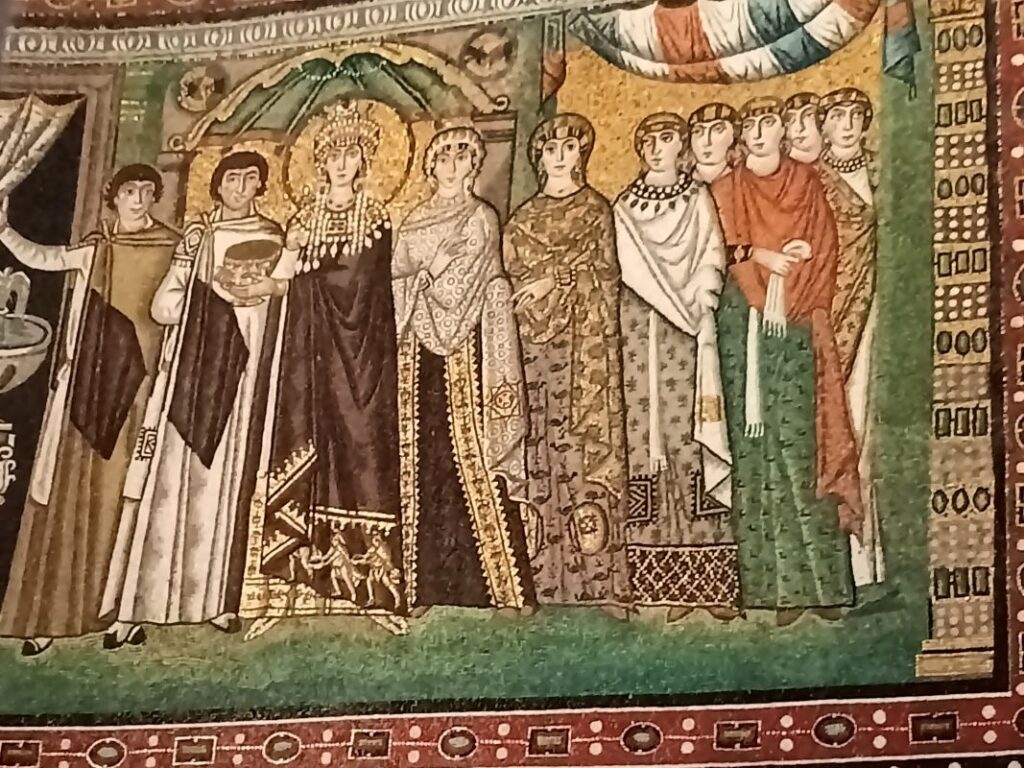
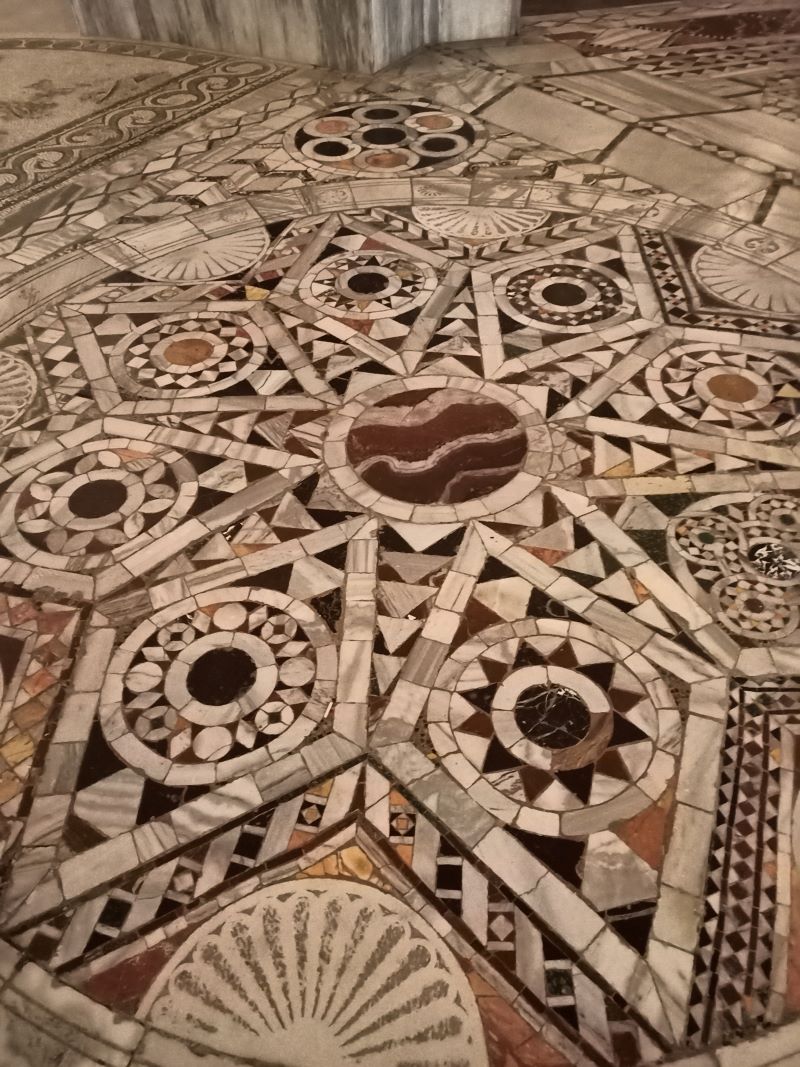
Exiting the mausoleum, we went across the small courtyard and entered the Basilica of San Vitale. Another UNESCO World Heritage Site, and another Byzantine treasure, the church is adorned from top-to-bottom. From the floors, across the eight walls (it is octagonal), and covering the ceiling, the whole inside is mosaiced. In the back of the church are two small, square pits, descending 3-4 steps. We learned these were created through the centuries, not by digging down but by raising the floor to keep it level with the surrounding ground. While the entire inside is decorated, the main mosaic is in the front, in the area of the presbytery and choir. One side depicts bible story scenes (there actually appeared to be about four bible stories meshed into one large scene) while the other illustrates the Virgin Mary, flanked by attendants. Mary is shown with a halo and crown, which are embedded with real gems, including rubies, emeralds, sapphires, and diamonds – the original builders spared no expense, and subsequent owners and users have managed to refrain from pilfering.
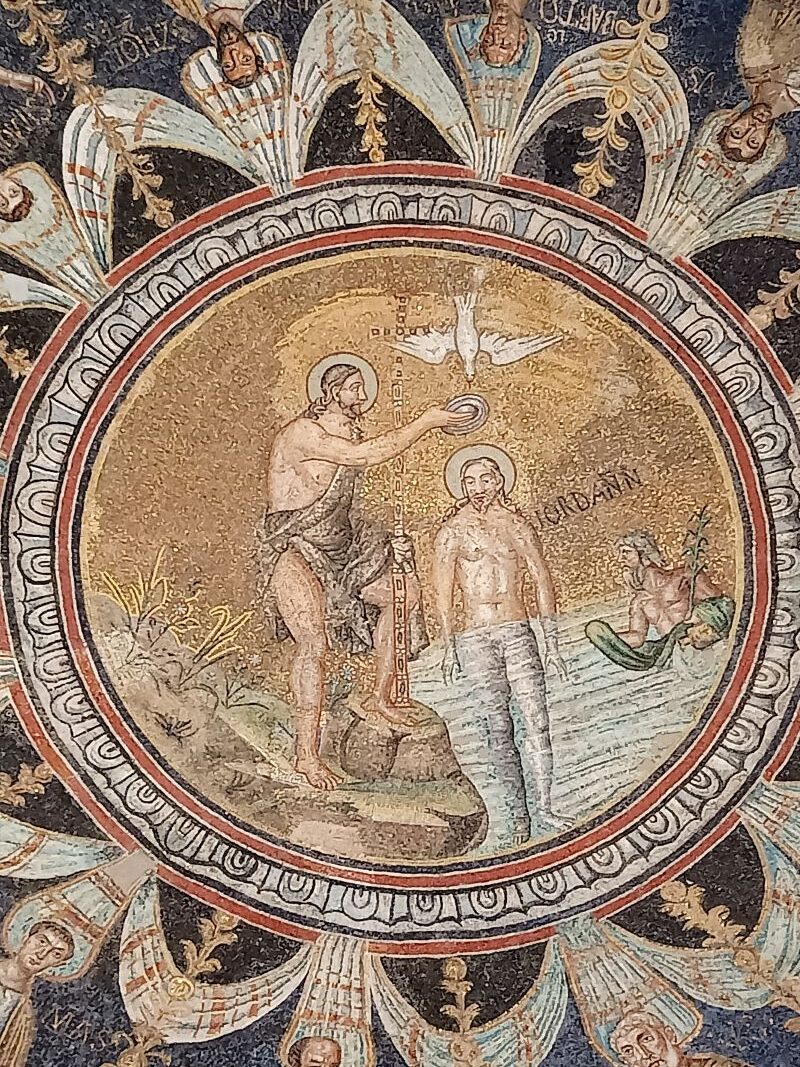
We finished our tour, and our look at Ravenna’s mosaics, with a visit to Baptisterio neoniano, the best-preserved baptismal building in the world. It sits next to the Duomo (the cathedral which no one was going in or out of, the main thing to see here was the small building beside it.) In the center is a large baptismal font to allow full immersion. Baptisms were an annual, or bi-annual event. The ceiling of the building contains a mosaic of Christ being baptized. If you look carefully, John the Baptist is pouring water over Christ’s head, and the vessel he is using was added later (it is different and lighter in color). The original would likely have had John touching Christ’s head, as was customary. Around the walls are alcoves, originally with small altars but now holding relics from the past.
Il Mercato
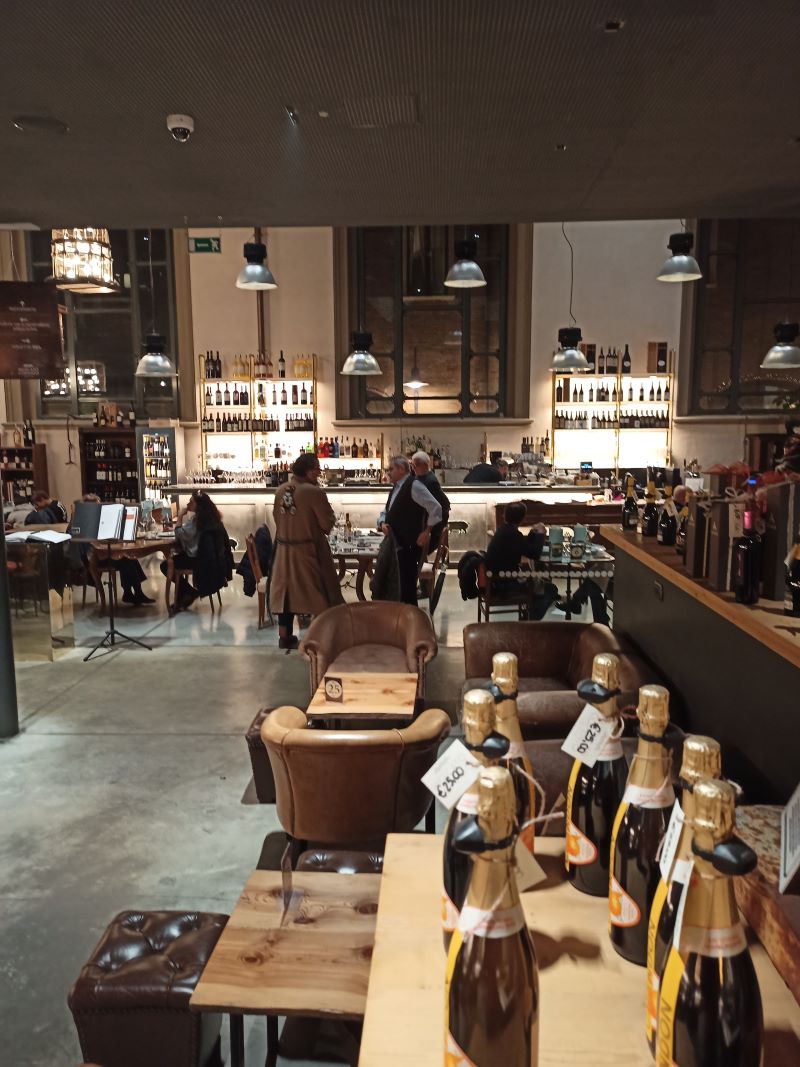
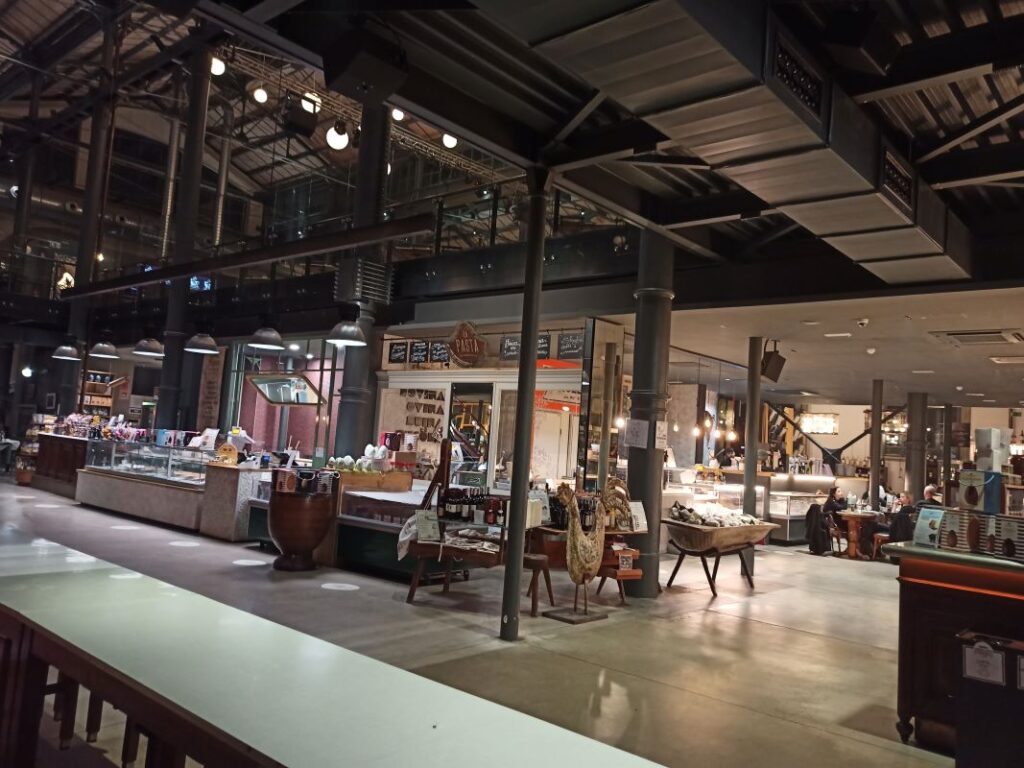
Impressed, better educated, parched, and famished, we were ready to partake in that Italian pursuit we have come to know and cherish – find somewhere to sit, have something to eat and drink, and watch people and the world go by. We headed toward il Mercato Coperto (the Covered Market). The place used to be an indoor central market but has been turned into an upscale type of eatery, where all the places are connected, the food is great (one of the shops is a pasta-maker, another is a butcher, one bakes bread), and you can get a bite to eat with a good glass of wine in interesting surroundings all day long and late into the night – if you are going there thinking it’s a “Market”, you will be disappointed. We shared a sandwich made with piada bread (if that sounds familiar it is because it is similar to pita (Greek) and pida (Turkish) – from the Byzantine influence, so everyone can pretend to eat local – that was part of “better educated”). It was good, maybe a tad over-priced but it’s kind of upscale. We also enjoyed a relaxing aperitivo and, thus refreshed, we were ready to hit some shops and embark on our afternoon passegiatta (stroll along the streets).
Our Last Supper – We’ll Be Back
We enjoyed a simple dinner at one of the restaurants suggested by the owner of our B&B. I had made reservations earlier in the day and we were able to get one of the last tables, again not at the time I asked for but close enough. Then called it a day.

Sunday morning, at the crack of 9:30, we went back to the Pasticceria for another cream-stuffed croissant. They also had these things called “bombas”, basically cream-filled donuts without the hole, which made the croissant seem tame. I tried one, and after my cappuccino and bomba, we walked off (I waddled) to do a final wander through Ravenna, check out if we needed to complete any last-minute shopping (the stores we wanted to go to were closed on Sundays, at least during the off-season, which was probably a good thing), and get ready to head home. The drive back was just as easy and pleasant as the one on Friday. Another nice sunny day with light traffic and clear roads. We arrived back in our little home in Guasticce having enjoyed another Later Gap adventure to a beautiful and wonderful Italian town. One that isn’t going to be included when you only have 1-2 weeks to visit a country, but one of the ones that makes Later Gap Travels special.
